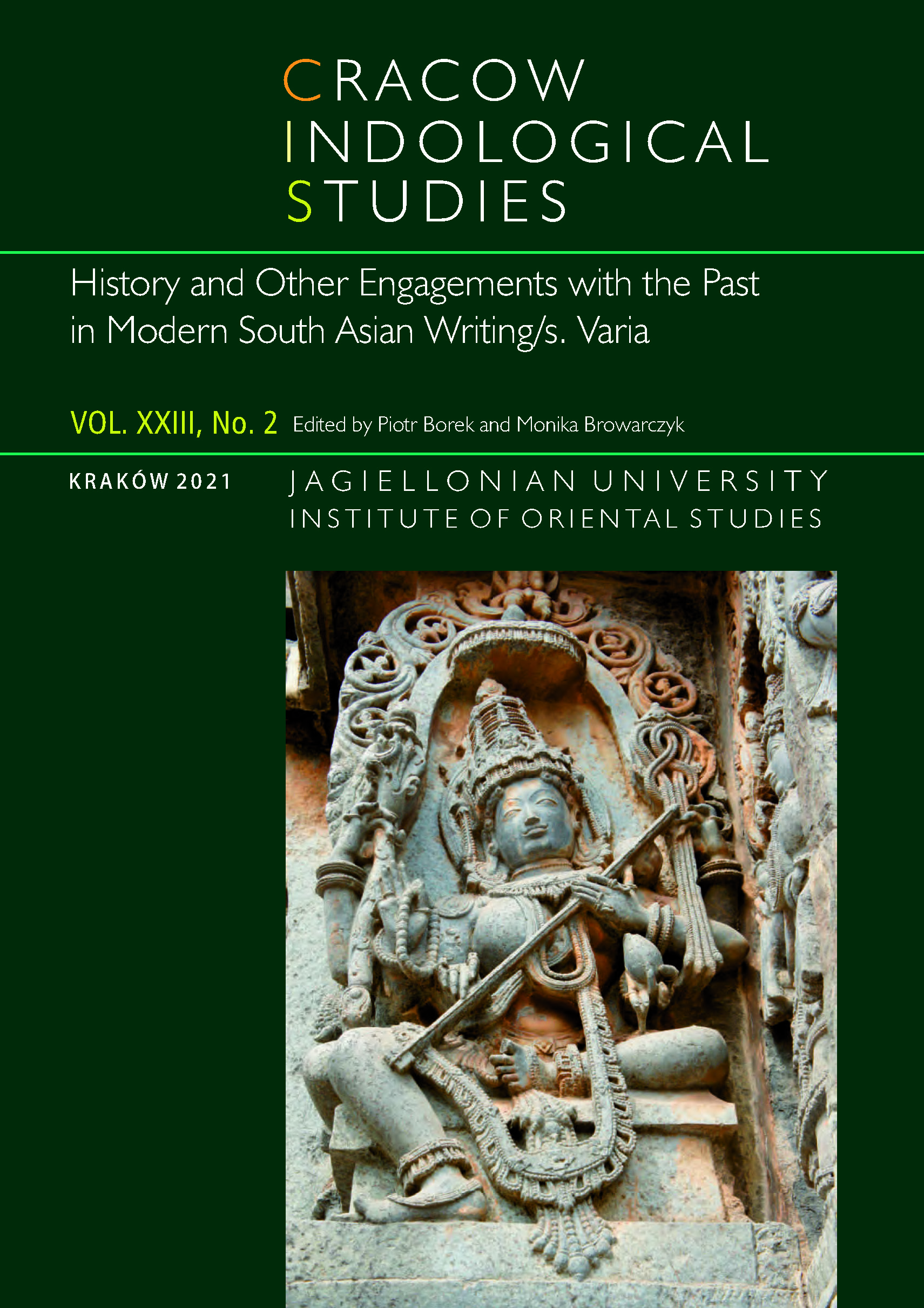Some Remarks on Computer Terminology in Persian and Hindi on the Basis of the Localizations of the Kdelibs4 Package
DOI:
https://doi.org/10.12797/CIS.23.2021.02.08Keywords:
Persian, Hindi, computer terminology, borrowing, language policyAbstract
Scientific and technological vocabulary, especially computer terminology, is a particularly interesting field in which to analyze/study the most recent trends in the development of vocabulary. The present article focuses on the Persian and Hindi translations of the Kdelibs4 software package. The author attempts to address a number of questions on the basis of the analyzed material, i.e., what are the origin and the proportion of loanwords within the analyzed vocabulary? Are the languages historically important as vocabulary donors (Arabic in the case of Persian and Persian in the case of Hindi) still prominent in this new sphere of vocabulary? What are the widespread syntactic and word-formational patterns among the discussed forms? The vocabulary in question is also juxtaposed with the official language policy in India and Iran, thus exhibiting various levels of deviations in both cases. The lexical items selected on the basis of objective criteria have been compared with the official vocabulary lists issued by the responsible/authoritative/ relevant governmental bodies. Additionally, in the case of Persian, an extensive Internet search has been performed to check their popularity among the users.
References
Amid, H. 1373 HŠ. Farhang-e Amid. Tehrān: Entešārāt-e Amir Kabir.
Bauer, B. L. M. 2017. Nominal Apposition in Indo-European: Its Forms and Functions, and Its Evolution in Latin-Romance. Berlin: De Gruyter Mouton. https://doi.org/10.1515/9783110461756. DOI: https://doi.org/10.1515/9783110461756
Burton-Page, J. 1960. The Etymology of Hindi ‘jagah:’ A Problem in Diffusion. In: Bulletin of the Deccan College Research Institute, 20(1–4): 288–290.
Casari, M. 2004. India XIV. Persian Literature. In: Encyclopædia Iranica, 13(1): 48–53, https://iranicaonline.org/articles/india-xiv-persian- literature-in-india, accessed on 30.03.2021.
Commission for Scientific & Technical Terminology 1995. Computer Science Glossary. New Delhi: Ministry of Human Resource Development, Department of Education, Government of India.
Commission for Scientific & Technical Terminology 2005. Glossary of Information Technology. New Delhi: Ministry of Human Resource Development, Department of Secondary and Higher Education, Government of India.
de Blois, F. 2004. Persian Literature – A Bio-Bibliographical Survey: Poetry of the Pre-Mongol Period. Vol. V. New York: Routledge. https://doi.org/10.4324/9780203647493, accessed on 20.03.2021. DOI: https://doi.org/10.4324/9780203647493
Dehkhoda, A. A. 1377 HŠ. Loqatnāme-ye Dehxodā. https://dehkhoda.ut.ac.ir/fa/dictionary, accessed on 20.03.2021.
Everaert, C. 2010. Tracing the Boundaries Between Hindi and Urdu: Lost and Added in Translation Between 20th Century Short Stories, Leiden–Boston: Brill. https://doi.org/10.1163/ej.9789004177314.i-300. DOI: https://doi.org/10.1163/ej.9789004177314.i-300
Galitz, W. O. 2007. The Essential Guide to User Interface Design: An Introduction to GUI Design Principles and Techniques. New York: Wiley.
Green, N. 2018. The Antipodes of “Progress:” A Journey to the End of Indo-Persian. In: A. Amanat, A. Ashraf (eds.). The Persianate World. Rethinking a Shared Sphere. Iran Studies Volume 18. Leiden: Brill. DOI: https://doi.org/10.1163/9789004387287_010
Jazayeri, M. A. 1999. Farhangestān. In: Encyclopædia Iranica. https://iranicaonline.org/articles/india-xiv-persian-literature-in-india accessed on 30.03.2021.
Kachru, Y. 1989. Corpus planning for modernization: Sanskritization and Englishization of Hindi. In: Studies in the Linguistic Sciences, 19(1): 153–164.
Kłagisz, M. 2013. Hints on French Loanwords in modern New Persian. In: Romanica Cracoviensia, 13(1): 38–51.https://doi.org/10.4467/20843917RC.13.004.1389.
Machowski, S. Machowska, L. 2020. Selected Present Terms Related to Special Language Translation and Its Morphological and Syntactic Analyses. In: S.Machowski (ed.). Grammatical Properties of Specialist Terminology in the Contemporary Medical and Medicine-related Language. Poznań: Wydawnictwo
Rys: 11–17. https://doi.org/10.48226/dwnuam.978-83-656666-08-5_2020.5.
Mallikarjun, B. 2004. Fifty Years of Language Planning for Modern Hindi.
The Official Language of India. In: Language in India, 4(11), http://www.languageinindia.com/nov2004/mallikarjunmalaysiapaper1.html, accessed on 31.03.2021.
Marszałek-Kowalewskia, K. 2011. Iranian Language Policy: A Case of Linguistic Purism. In: Investigationes Linguisticae. Vol. XXII. Poznań: Adam Mickiewcz University: 89–103. https://doi.org/10.14746/il.2010.22.5. DOI: https://doi.org/10.14746/il.2010.22.5
McGregor, R. S. 1993. The Oxford Hindi-English Dictionary. Oxford–New York: Oxford University Press.
Monier-Williams, M. 1872. A Sanskrit-English Dictionary Etymologically and Philologically Arranged with Special Reference to Greek, Latin, Gothic, German, Anglo-Saxon, and Other Cognate Indo-European Languages. Oxford: The Clarendon Press.
Rezā’i-Bāqbidi, H. 1997. Barresi-ye čand vāže-ye daxil-e hendi dar še’r-e fārsi. In: Nāme-ye Farhangestān, 2(4): 103–116.
Steingass F. J. 1892. A Comprehensive Persian-English Dictionary, Including the Arabic Words and Phrases to be met with in Persian Literature. London: Routledge & K. Paul.
Svobodová, B. 2006. The English Influence on Hindī. Univerzita Karlova v Praze. https://is.cuni.cz/webapps/zzp/detail/27257/.
Teli, G. 2012. Revisiting the Making of Hindi as a ‘National’ Language. In: Language in India, 12(1), http://www.languageinindia.com/ jan2012/ganpathindianationalfinal.pdf, accessed on 30.03.2021.
Turner, R. L. 1962–1966. A Comparative Dictionary of Indo-Aryan Languages. London: Oxford University Press.
Verma, M. K. 2007. Bhojpuri. In: D. Cardona, Dh. Jain (eds.). The Indo-Aryan Languages. Oxon–New York: Routledge.
Farhangestān-e zabān wa adab-e fārsī. Sāmāne-ye vāže-yār, http://vajeyar.apll.ir/,accessed on 30.03.2021.
Downloads
Published
Issue
Section
License

This work is licensed under a Creative Commons Attribution-NonCommercial-NoDerivatives 4.0 International License.






